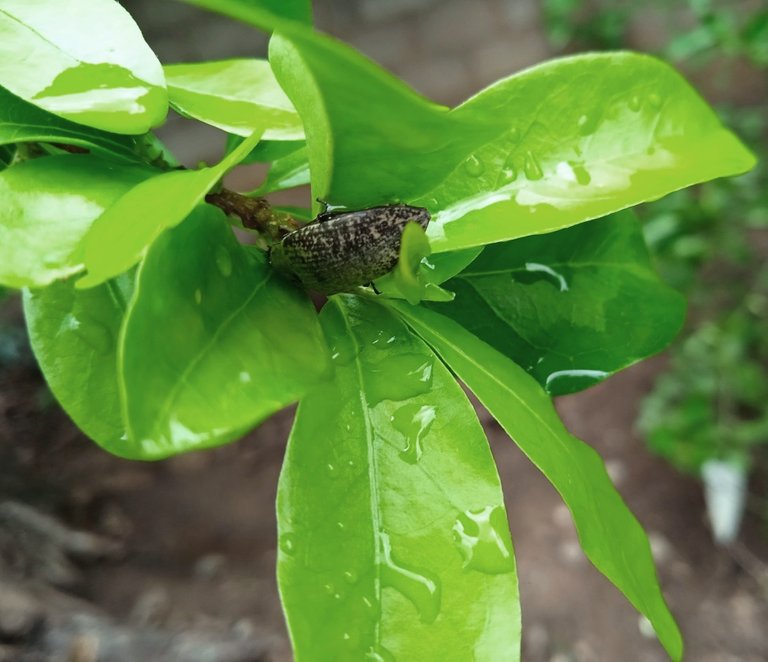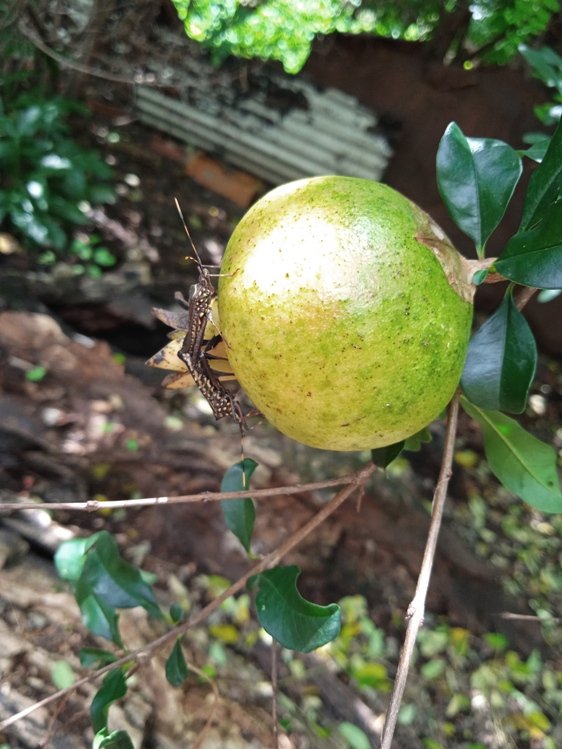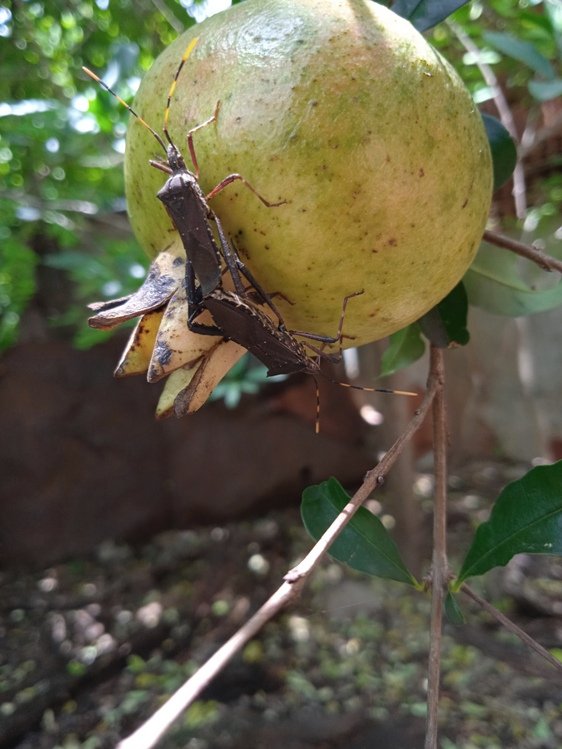Chinches / Bedbugs: Halymorpha halys y Leptoglossus occidentalis [ESP/ENGL]

Greetings again, beautiful Insects Of The World community, today I am back to share some inhabitants of my lot, and it is about two varieties of bedbugs. I saw these individuals weeks ago, in my usual walks through my patio. The first of them, the marbled bug (Halymorpha halys), I observed after a rainy day, on one of the leaves of one of the semeruco plants (Malpighia emarginata), I don't know if it was trying to eat or just taking sun, but there I saw him. The other pair of bugs, known as foots bugs (Leptoglossus occidentalis), I was able to observe one midday in one of the fruits of the pomegranate (Punica granatum), copulating.

According to my review with the Gloogle Lens application, I was able to identify them by their respective scientific names, because where I live these insects are only called bedbugs, without further ado, even when morphologically they are very different from each other; however, I am well aware that each species of insect has its own classification, name and characteristics, so it is important to be able to identify them.

The marbled bug was the first one I saw. Unfortunately I couldn't photograph it in more detail because it took flight, and fortunately I haven't seen it anymore. According to the consulted bibliography (please review the links that I share at the end of this post), this is a pest of Asian origin, which devastates crops. Its expansion towards other areas of the planet is presumed to be due to the trade in fruits, vegetables, etc.; that can be contaminated. Here there is a serious problem, it is that then we would be facing an exospecies or foreign species, which, because it is foreign to this habitat, has no natural predators and can expand in a very short period of time, doing a lot of damage; however, according to my personal experience, I have barely observed this insect twice. I suppose that just as it happens in Asia, where a small wasp parasitizes its eggs, one of the pollinators of the solar, (it could be one of the small wasps), will behave in the same way, thus being its predator; but these are simple conjectures or speculations on my part, I cannot assert this with absolute certainty, because I have not seen it, I have not verified it.


The other pair of bugs, which were very comfortable in their love nest on top of a pomegranate fruit, are the paton bugs or Leptoglossus occidentalis, insects of considerable size, each one measuring approximately two centimeters , being very similar to each other, so I cannot say that there is sexual dimorphism. These insects, according to the consulted bibliography, are not native to South America either, that is, they are also an exospecies. They are native to North America, but like the marbled bug, they have spread beyond its borders. It is also considered a pest, since it affects various crops such as pineapple and pine trees. I think I have seen these insects more often in my lot, but barely four times.




Here I end my post today, in which I wanted to share my observations about two insects from the same category, which are potentially harmful. Greetings.

Fuente documental / documentary source
Todas las fotos de este post son de mi autoría y fueron tomadas con mi teléfono Xiomi REDMI 8 A // These photos are my own, and were taken with a Xiomi REDMI 8 A phone
Los divisores son cortesía de @eve66 quien comparte bellos diseños que embellecen el maquetado de nuestras publicaciones. // The dividers used are courtesy of @eve66 who shares beautiful designs that embellish the layout of our post.
En caso de que se requiera utilizar el contenido o las imágenes de este post y de mis otras publicaciones, agradecería que se hiciera referencia a mi autoría (Fabiola Martínez) y se citara el enlace correspondiente. Gracias. // In case it is required to use the content or images of this post and of my other publications, I would appreciate if you could refer to my authorship (Fabiola Martínez) and cite the corresponding link. Thanks.

 Delegations welcome!
Delegations welcome!


We appreciate your work and your post has been manually curated on behalf of Insects Of The World Community. It will be added to the weekly curation report. Keep up the good work.
Thanks for your valuable support!
Thanks for sharing.
We appreciate your work and your post was manually curated by @none! from the DNA team!
Reach us on Discord to learn more about the project!
Thanks for your valuable support!
https://www.reddit.com/r/Insect/comments/1mpq0lz/bedbugs_halymorpha_halys_y_leptoglossus/
This post has been shared on Reddit by @sirenahippie through the HivePosh initiative.